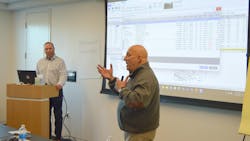With more parts needed to repair the average vehicle due to vehicle complexity, additional ways to order them, and pressure on shop owners and operators – especially those graded on a direct repair program’s “scorecard,” there is often a gap in how they and their suppliers communicate what is important to them.
To bring them together, Subaru of America Fixed Operations and Mike Anderson of Collision Advice joined to offer workshops around the country. Participants include Subaru dealership parts managers and other fixed operations personnel and shop owners and operators, where each gains perspective on their business challenges.
FenderBender was invited to attend the daylong Feb. 6 meeting at Collision Advice Headquarters, in La Plata, Maryland, with attendees from both the Washington, D.C., metro and surrounding areas.
Shops are replacing more parts and doing fewer repairs, Anderson said, largely due to ADAS and advanced substrates. Those have gone from an average number of parts per claim, he said, of 8.4 in 2011 to 12.7 in 2022, which is now up to 42% of the total repair cost, according to CCC Intelligent Solutions research. That means lower gross profit, and more sublet operations are also now needed – as much as 10% more.
That can result in shops “squeezing vendors for more margin” to help make up the losses, he said. But overall, “the availability of parts is much more important than the price. Time is the most important thing to the shop.”
Shop operators at the meeting noted that parts departments (of all vehicle makes) often are too optimistic with the ETA of a part, causing missed delivery dates. If it’s too late to get a critical part on today’s shipment, the shop may be OK with picking it up at the dealership. Similarly, Anderson noted, it may be desirable to get expedite shipping to receive a part faster. Insurers, facing longer cycle times and the need to hold back more money in escrow, usually pay the extra cost without issue.
Some highlights from previous meetings of what shops want from their parts supplier, Anderson said, include the ability accept electronic parts ordering, the ability to scrub a parts order by VIN, good inventory, great communication, willing to search inventory of other dealers, a fair discount (not necessarily the lowest cost), knowledgeable staff, billing parts in sequential order to match the shop PO from the management system, and timely credit-processing.
What dealers want from their customers are loyalty to the supplier and in using OEM parts, avoiding last-minute orders, sending only one parts order per vehicle, electronic ordering, minimal returns, and paying their bill on time.
About the Author
Jay Sicht
Editor-in-Chief, FenderBender and ABRN
Jay Sicht is editor-in-chief of FenderBender and ABRN. He has worked in the automotive aftermarket for more than 29 years, including in a number of sales and technical support roles in paint/parts distribution and service/repair. He has a bachelor's degree in journalism from the University of Central Missouri with a minor in aviation, and as a writer and editor, he has covered all segments of the automotive aftermarket for more than 20 of those years, including formerly serving as editor-in-chief of Motor Age and Aftermarket Business World. Connect with him on LinkedIn.
Don't miss Jay's next article or podcast. Sign up for FenderBender Today's Collision Repair News and ABRN eNews here.

